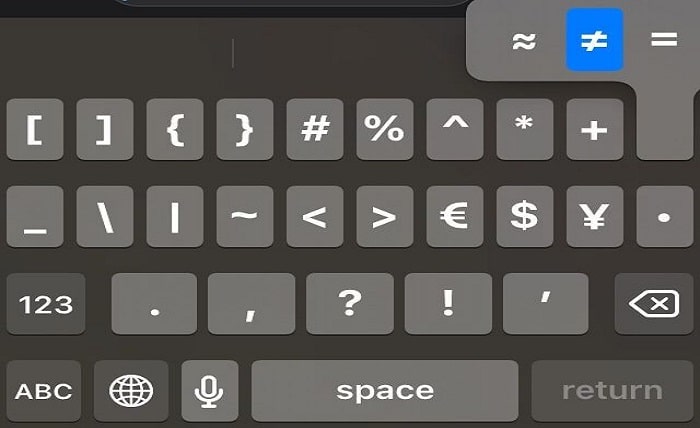Not Equal Sign: A Comprehensive Guide

Introduction
The not equal sign (≠) is a fundamental symbol in mathematics, programming, and various fields that involve data comparison. It represents the concept of inequality, a principle that has vast applications in problem-solving, logical reasoning, and algorithm design. This blog post will delve into the origins, uses, and importance of the not equal sign, providing a thorough understanding of its role in different contexts.
The Origins of the Not Equal Sign
The not equal sign has a rich history, with its roots tracing back to early mathematical notation. Initially, mathematicians used different methods to denote inequality, but the modern symbol (≠) was introduced by the British mathematician John Wallis in the 17th century. Understanding its origins helps appreciate its evolution and standardized use in mathematics today.
Basic Mathematical Use of the Not Equal Sign
In mathematics, the not equal sign is used to indicate that two values are not the same. For example, if x ≠ y, it means that the value of x is not equal to the value of y. This basic usage is crucial in solving equations, inequalities, and in expressing various mathematical relationships that do not conform to equality.
The Not Equal Sign in Algebra
In algebra, the not equal sign plays a pivotal role in solving equations and inequalities. It is often used to set conditions and constraints in problems, helping to identify solution sets that meet specific criteria. For instance, in quadratic equations, specifying x ≠ 0 might be necessary to avoid undefined expressions.
Applications in Geometry
Geometry also utilizes the not equal sign to define properties of shapes and figures. When comparing lengths, angles, or areas, the not equal sign helps to articulate that certain measurements do not match. This is essential in proofs and in establishing relationships between different geometric elements.
The Not Equal Sign in Programming
Programming languages heavily rely on the not equal sign to perform comparisons and control flow operations. In languages like Python, Java, and C++, the not equal sign is represented as !=. This operator is used in conditional statements to execute code blocks based on the inequality of variables, making it a fundamental aspect of logical operations in software development.
Not Equal Sign in Database Queries
In SQL and other database query languages, the not equal sign is vital for filtering data. When querying databases, != or <> (depending on the SQL dialect) is used to retrieve records that do not match a specified value. This capability is essential for data analysis, reporting, and maintaining data integrity.
Logical Expressions and the Not Equal Sign
Logical expressions frequently incorporate the not equal sign to assert non-equivalence. In formal logic, the not equal sign is used to differentiate between distinct propositions or entities. This is crucial in constructing logical arguments and in the study of discrete mathematics.
The Not Equal Sign in Everyday Life
Beyond technical fields, the not equal sign finds relevance in everyday situations. It is used to compare quantities, assess different options, and make decisions based on non-equivalence. For example, when choosing between products, noting that their prices are not equal can be a deciding factor.
Visual Representation and Unicode
The visual representation of the not equal sign is standardized in Unicode as U+2260. This ensures consistency across digital platforms and documents. Recognizing its Unicode value is important for programmers and content creators who need to incorporate the symbol into their work correctly.
Teaching the Not Equal Sign
Educators play a crucial role in teaching the concept of the not equal sign to students. Introducing this symbol in early mathematics education helps students develop a strong foundation in logical reasoning and problem-solving. Practical examples and exercises can enhance their understanding and application of the not equal sign in various contexts.
Read More: Mega Famous 10000 followers
Conclusion
The not equal sign is a versatile and essential symbol that transcends mathematics, programming, and everyday reasoning. Its ability to denote inequality allows for precise expression and analysis of non-equivalence in numerous fields. By understanding its history, applications, and importance, one can appreciate the profound impact of the not equal sign on logical thought and problem-solving.
Read More: How to Join a Blooket Game Blooket Login
FAQs
1. What is the not equal sign used for in mathematics?
The not equal sign (≠) in mathematics is used to indicate that two values are not the same. It is essential for solving equations and expressing inequalities.
2. How is the not equal sign represented in programming?
In programming, the not equal sign is commonly represented as != in languages like Python, Java, and C++. It is used to compare variables and control program flow based on inequality.
3. Can the not equal sign be used in database queries?
Yes, the not equal sign is used in database queries to filter data. In SQL, it can be represented as != or <> depending on the dialect, to retrieve records that do not match a specified value.
4. Why is the not equal sign important in logical expressions?
The not equal sign is important in logical expressions because it helps assert non-equivalence, which is crucial for constructing logical arguments and differentiating between distinct propositions.
5. How can educators effectively teach the not equal sign?
Educators can teach the not equal sign by providing practical examples, exercises, and emphasizing its applications in various contexts. Introducing it early in mathematics education helps build a strong foundation for logical reasoning and problem-solving.
Read More: How to Join a Blooket Game Blooket Join




